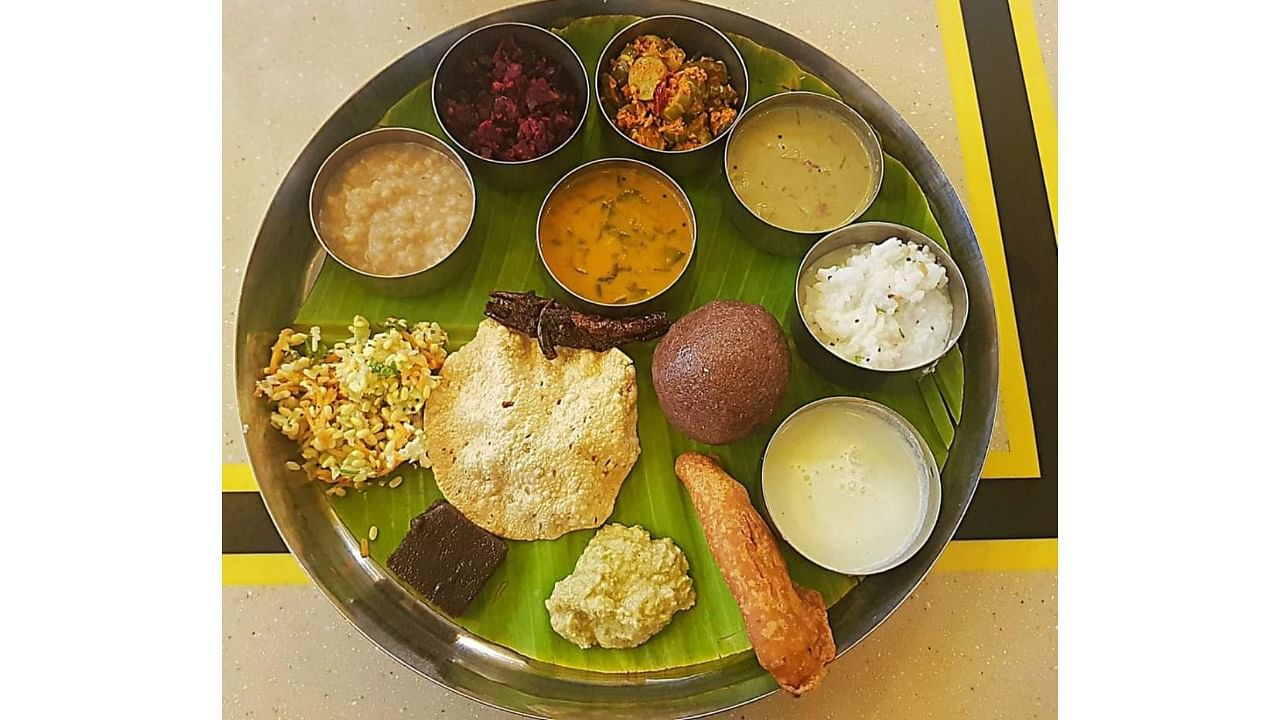
A South Indian thali by chefs Ramya and Raghunath.
Credit: Special Arrangement
Satvik food gained popularity, especially during the pandemic when people cooked more at home. Post-Covid, there was a heightened awareness about food sources and greenhouse gas emissions, leading many to embrace a plant-based diet rooted in Ayurveda.
However, preparing Satvik food requires specific dos and don’ts of cooking. Only fresh and seasonal ingredients are used for cooking. The cooked food is to be consumed within a few hours. “Satvik cooking is simple cooking which does not destroy the ‘prana’ (life) energy of the food. It has to be cooked in a clean place by a person who is clean in their thoughts,” says Dr Pratap Chauhan, director of Jiva Ayurveda, Faridabad. ‘Satvik’ comes from the Sanskrit word ‘Sattva’, which means pure, and clean with an energetic vibe.
Most vegetarian produce and food that are fresh, local and seasonal are considered Satvik. Both raw and cooked seasonal food could be eaten. Fresh vegetables and fruits, whole grains, pulses, millets, cow’s milk, ghee, buttermilk, herbs, honey, jaggery, sprouts, soaked nuts; and dishes like khichdi, dalia, oats, poha, upma, idli, dosa, sprouts salad, roti, cheela made of ragi or moong, sabudana (sago) vada among others are considered Satvik. The indigenous Satvic drinks include buttermilk, sattu sherbet, aam panna, bael sherbet, ragi, sabja (sweet basil seeds) and thandai.
Food that is non-seasonal, highly processed, preserved, frozen, bakery items, packaged and canned food, refrigerated, reheated food, junk food, onions, garlic and mushrooms are not Satvik. Even deep frying, heavy use of spices, overcooking, marinating and mixing food items that are ‘viruddha’ (incompatible) is not Satvik.
Satvik food becomes a natural choice during summer as it boosts gut health, detoxifies the body and restores balance. Taking a cue from the weather, the human body has to attain an equilibrium with the external environment.
Even though, switching completely to a Satvik diet might not be possible for many, incorporating a few Satvik meals a week could benefit the body.
“During the change of season, our digestive fire (Jatharagni in Ayurveda) and metabolism are in a transition phase, so the digestion or metabolism is not strong. Therefore, Ayurveda advises eating Satvik food that is fresh, natural, easy to digest and nutritious,” says Dr Chauhan.
To debunk the perception that Satvik food is bland, chefs experiment with fresh ingredients and heirloom grains to make appetising and appealing Satvik dishes.
“To make it trendy, the key is choosing healthier alternatives by picking the right ingredients. Noodles or pasta could be made with millet or wheat, while papdi chat could be enjoyed with multigrain crispies, a mint and potato concoction, green chutney, fenugreek leaves and sprouts,” says chef Ani Setia of Jaipur. Eating Satvik is a journey of eating fresh and making a few healthy changes in your meal, so the taste and nutrients of the grains and vegetables are not compromised by adding too much oil and spices.
“A Satvik diet is a healthy way of living that increases our immunity, aids digestion, detoxes the body, reduces stress and leaves us feeling more energetic,” says Reetu Uday Kugaji, a culinary expert and chef consultant from Mumbai. She has been trying out recipes that adhere to Satvik cooking yet taste delicious. Some traditional treats include Kashi halwa (ash gourd halwa), chawal ki kheer and almond and saffron-flavoured milk. She has also experimented with baked sweet potato, quinoa apple and almond kheer, pumpkin soup with coconut milk and hummus without garlic.
For Bengaluru-based couple Ramya and Raghunath who are chefs and restauranteurs, adopting Satvik food completely transformed their health and now they want to share its goodness with others. Ramya firmly believes in ‘you are what you eat’ and to combat the stress in life, eating right is essential. They ensure that a technique of roasting spices in a closed vessel and cryogenic grinding (freeze-roasted spices at -196 degrees) is used to retain the nutrients and flavour of the essential oil of the spices. Cold-pressed oil, Himalayan pink salt, organic millets, grains with low glycemic index and heirloom grains like local jave godhi and red rice are staples in their cooking. In Ayurveda, the Satvik diet is known for offering a healthy life and keeping our minds clear and stable. In light of the negative impacts of consuming processed meals and living stressful lifestyles, people may find it helpful to learn about Satvik food.